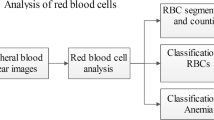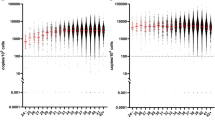Abstract
The aim of this study was to determine the haematological reference values of a population of dromedary camels (Camelus dromedarius) in northern Nigeria to provide data required during laboratory investigation of health. The haematological variables were determined with EDTA anti-coagulated blood samples collected from the jugular veins of 121 camels during antemortem sessions at the abattoir in Maiduguri (Borno State). Serum total protein, albumin and globulin concentrations were estimated with serum samples harvested from clotted blood samples collected from the same animals. The haematological data were normally distributed (except monocyte and basophil counts) and values were presented as means, standard deviations, medians, minimum and maximum limits. Packed cell volume (PCV) significantly (p < 0.05) correlated (r = 0.30–0.90) with erythrocyte count (EC), haemoglobin concentration (Hb), total leukocyte counts (TLC) and absolute differential leukocyte count (DLC), but did not correlate (r = 0.01–0.17) with calculated erythrocyte indices. Stratification of the reference data based on PCV produced sub-classes of variables (EC, Hb, TLC, DLC) with significant (p < 0.05) variations. The PCV had no significant correlation with serum total protein, albumin and globulin concentrations indicating lack of haemoconcentration. The variables had broad value range and were neither influenced by sex and age nor dehydration. Lymphocytes were the most numerous in DLC with neutrophil-lymphocyte ratio of 0.23–1.15. In conclusion, the haematological reference values of dromedary camels varied widely and had positively correlated variables suggesting the possibility of partitioning the dataset into sub-groups with low and high values in order to enhance their application.


Similar content being viewed by others
References
Abdalla OM, Wasfi IA, Gadir FA (1988) The Arabian race camel normal parameters. 1. Haemogram, enzymes and minerals. Comp Biochem Physiol A Physiol 90(2):237–239
Abdussamad AM, Charruau P, Kalla DJU, Burger PA (2015) Validating local knowledge on camels: colour phenotype and genetic variations of dromedaries in Nigeria-Niger corridor. Livest Sci 181:131–136
Adah AS, Ayo JO, Rekwot PI, Arimie DI (2017) Haematological profile of the one-humped camel subjected to packing (load carrying) in harmattan season in semi-arid region of Nigeria. Bangl J Vet Med 15(1):39–44
Aichouni A, Jeblawi R, Dellal A, Hammou H, Aggad H (2010) Breed variations in blood constituents of the one-humped camel (Camelus dromedarius) in Algeria. J Camelid Sci 3:19–25
Al-Busadah KA (2007) Some biochemical and haematological indices in different breeds of camels in Saudi Arabia. Scien J King Faisal Univ Basic Appl Sci) 8(1):131–140
Al-Busadah KA, Osman TEA (2000) Haematological parameters of adult dry, lactating and camel calves in Saudi Arabia. Pak J Biol Sci 3(10):1749–1751
Al-Harbi MS (2012) Some hematological values and serum biochemical parameters in male camels (Camelus dromedarius) before and during rut. Asian J Anim Vet Adv. https://doi.org/10.3923/ajava.2012
Al-Sultan SI (2008) Studies on haematological and certain serum biochemical values in young Magaheim dromedary camels at Al-ahsa province. Vet Res 2(3):34–37
Auer R, Gleiβ A, Windberger U (2015) Towards a basic understanding of the properties of camel blood in resoponse to exercise. Emirates J Food Agric 27(3):302–311
Baba SS, Ambali AG, Zaria LT, Kalra (1994) Abattoir records of slaughtered camels (Camelus dromedarius) in Nigeria. Bull Anim Health Prod Afr 42:253–257
Egbe-Nwiyi TN (1995) Effects of environmental temperature on haematological values of apparently healthy camels (Camelus dromedarius). Israel J Vet Med 50(1):35–37
Egbe-Nwiyi TNC, Paul BT, Muhammed YY (2016) Haemoparasites and haematological parameters of one-humped camel (Camelus dromedaries) slaughtered in Maiduguri abattoir, Nigeria. Global J Med Res: Vet Sci Vet Med 16(2):10–16
Farooq U, Samad HA, Khurshid A, Sajjad S (2011) Normal reference hematological values of one-humped camels (Camelus dromedarius) kept in Cholistan desert. J Anim Plant Sci 21(2):157–160
Fatihu MY, James AS, Abubakar MB (2000) Hematological data of healthy and natural Trypanosoma evansi infected camels (Camelus dromedaries) in Sokoto, Nigeria. J Protozool Res 10(1):1–5
Friedrichs KR, Harr KE, Freeman KP, Szladovits B, Walton RM, Barnhart KF, Blanco-Chavez J, American Society for Veterinary Clinical Pathology (2012) ASVCP reference interval guidelines: determination of de novo reference intervals in veterinary species and other related topics. Vet Clin Pathol 41:441–453
Gaughan JB (2011) Which physiological adaptation allows camels to tolerate high heat load and what more can we learn? J Camelid Sci 4:85–88
Geffré A, Friedrichs K, Harr K, Concordet D, Trumel C, Braun J-P (2009) Reference values: a review. Vet Clin Pathol 38(3):288–298
Gentz EJ, Pearson EG, Lassen ED, Snyder SP, Sharpnack E (1994) Polycythemia in a llama. J Am Vet Med Assoc 204(9):1490–1492
Ghodsian I, Nowrouzian I, Schels HF (1978) A study of some haematological parameters in Iranian camel. Trop Anim Health Prod 10(2):109–110
Gupta BD, Joshi BP, Rai P (1979) Observations on haematology of camel (Camelus dromedarius). Indian Vet J 56:269–272
Hamad B, Aggad H, Hadef L, Adaika A (2017) Effect of cold and hot season on thermoregulation and haemogram blood parameters of dromedary camel (Camelus dromedarius) in Algeria. Livestock research for rural development 29 article #140. http://www.Irrd.org/Irrid29/7/brah29140.html
Hawkey CM, Gulland FMD (1988) Haematology of clinically normal and abnormal captive llamas and guanacoes. Vet Rec 122:232–234
Igbokwe IO (1997) The effects of water deprivation in livestock ruminants: an overview. Nutr Abstr Rev (Series B) 67(12):905–914
Igbokwe IO, Ajuzieogu GI (1991) The haematological effects of acute water deprivation in Yankasa sheep. Vet Res Commun 15:69–71
Igbokwe NA, Ojo NA, Igbokwe IO (2015) Effects of sex and age on the osmotic stability of Sahel goat erythrocytes. Comp Clin Pathol 25:15–22
Islam S, Ferdous J, Rahaman MK, Akter S, Hassan MM, Islam A (2019) Reference values for hematological and serum biochemical parameters of dromedary camel (Camelus dromedarius) in sub-tropical climate of Bangladesh. Adv Anim Vet Sci 7(4):232–237
Jain NC (1998) Essentials of veterinary hematology, 2nd edn. Lea & Febiger, Philadelphia, pp 65–68
Jaji AZ, Elelu N, Mahre MB, Jaji K, Mohammed LIG, Likita MA, Kigir ES, Onwuama KT, Saidu AS (2017) Herd growth parameters and constraints of camel rearing in northeastern Nigeria. Pastorialism 7:16. https://doi.org/10.1186/s13570-017-0089-x
Jalali SM, Hasani YN, Darabifard A, Mavadati AH (2018) A study of hematologic and biochemical profile in female dromedary camels during the breeding and non-breeding season. Comp Clin Pathol 27(3):655–659
Joshi AB, Lateef A, Haque N, Patel AG, Patel PA (2017) Erythrocytic indices of kutchi camel during different stages of lactation. Adv Anim Vet Sci 5(11):456–459
Kamalu TN, Okpe GC, Williams A (2003) Haematological studies in apparently normal adult camels (Camelus dromedarius) of north East Sahel region of Nigeria. Glob J Agric Sci 2(1):5–8
Karesh WB, Uhart MM, Dierenfeld ES et al (1998) Health evaluation of free-ranging guanaco (Lama guanicoe). J Zoo Wildl Med 29:134–141
Khan Z, Nawaz M, Khan A, Bacha U (2013) Haemoglobin, red blood cell counts, haematocrits and derived parameters for diagnosing anaemia in elderly males. Proc Pak Acad Sci 50(3):217–226
Mohamed HA, Hussein AN (1999) Studies on normal haematological and serum biochemical values of the ‘Hijin’ racing camels (Camelus dromedarius) in Kuwait. Vet Res Commun 23:241–248
Mohamed MH, Mohamed AH, Locatelli A (1984) Water deprivation effects on the hematological and hematochemical pictures of Camelus dromedarius. Rev Élev Méd Vét Pays Trop 3(3):313–317
MohammedI, HoffmanI (2006) Management of draught camels (Camelus dromedarius) in crop-livestock production systems in Northwest Nigeria. Livestock research for rural development 18, article #16. http://www.Irrd.org/Irrid18/1/moha18016.html
Ramadan RO (1994) Surgery and radiology of the dromedary camel, 1st edn. Al-Jawad Printing Press, Kingdom of Saudi Arabia, pp 24–30
Ribadu AY, Ogwu D, Njoku CO, Eduvie LO (1991) An abattoir survey of female genital disorders of imported camels (Camelus dromedarius) in Kano, Nigeria. Brit Vet J 147:290–292
Saeed A, Hussein MM (2008) Change in normal haematological values of camels (Camelusdromedarius): influence of age and sex. Comp Clin Pathol 17:263–266
Saeed A, Khan IA, Hussein MM (2009) Change in haematological profile of pregnant camels (Camelus dromedarius) at term. Comp Clin Pathol 20(1):53–55
Sarwar A, Majeed MA (1997) Interrelationships between 30 parameters of blood in normal one-humped camel in summer. J Camel Pract Res 4:35–40
Snow DH, Billah A, Ridha A (1988) Effect of maximal exercise on the blood composition of racing camel. Vet Rec 123(12):311–312
Tornquist SJ (2010) Hematology of camelids. In: Weiss DJ, Wardrop KJ (eds) Schalm’s veterinary hematology, 6th edn. Blackwell Publishing, Ames, pp 910–917
Tornquist SJ, Rigas J (2010) Interpretation of ruminant leukocyte responses. In: Weiss DJ, Wardrop KJ (eds) Schalm’s veterinary hematology, 6th edn. Blackwell Publishing, Ames, pp 307–313
Turkson PK, Ganyo EY (2015) Relationship between haemoglobin concentration and packed cell volume in cattle blood samples. Onderstepoort J Vet Res 82(1):1–5
Vap L, Bohn AA (2015) Hematology of camelids. Vet Clin Exot Anim 18:41–49
Velguth KE, Payton ME, Hoover JP (2010) Relationship of haemoglobin concentration to packed cell volume in avian blood samples. J Avian Med Surg 24(2):115–121
Yagil R, Sod-Moriah UA, Meyerstein N (1974) Dehydration and camel blood. 1. Red blood cell survival in one-humped Camelus dromedarius. Am J Phys 226(2):298–300
Yahaya A, Olopade JO, Kwari HD, Wiam IM (2012) Investigation of osteometry of the skull of the one-humped camels part II: sex dimorphism and geographical variations in adults. Ital J Anat Embryol 117(1):34–44
Acknowledgements
Technical assistance was provided by Modu B Monguno, Abdullahi Aza, Samaila A Gadaka, Abubakar Waziri, Tijjani Goni Aji and Hussaini Lawan.
Funding
Financial assistance was granted by the Council of the University of Maiduguri through a study fellowship to Ali Waziri.
Author information
Authors and Affiliations
Corresponding author
Ethics declarations
Ethical compliance
The research was approved by the School of Postgraduate Studies Board of the University of Maiduguri, Maiduguri, Nigeria, after meeting institutional, national and international standards for research on animals.
Conflict of interests
The authors declare no conflict of interest with respect to data collection and presentation of the contents of the research.
Additional information
Publisher’s note
Springer Nature remains neutral with regard to jurisdictional claims in published maps and institutional affiliations.
Rights and permissions
About this article
Cite this article
Waziri, A., Hassan, S.U. & Igbokwe, I.O. Haematological reference values of dromedary camels in northern Nigeria. Comp Clin Pathol 28, 1769–1777 (2019). https://doi.org/10.1007/s00580-019-03018-6
Received:
Accepted:
Published:
Issue Date:
DOI: https://doi.org/10.1007/s00580-019-03018-6




